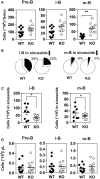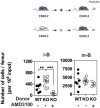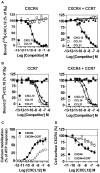Coexpression of CCR7 and CXCR4 During B Cell Development Controls CXCR4 Responsiveness and Bone Marrow Homing
- PMID: 31921208
- PMCID: PMC6930800
- DOI: 10.3389/fimmu.2019.02970
Coexpression of CCR7 and CXCR4 During B Cell Development Controls CXCR4 Responsiveness and Bone Marrow Homing
Abstract
The CXCL12-CXCR4 axis plays a key role in the retention of stem cells and progenitors in dedicated bone marrow niches. It is well-known that CXCR4 responsiveness in B lymphocytes decreases dramatically during the final stages of their development in the bone marrow. However, the molecular mechanism underlying this regulation and whether it plays a role in B-cell homeostasis remain unknown. In the present study, we show that the differentiation of pre-B cells into immature and mature B cells is accompanied by modifications to the relative expression of chemokine receptors, with a two-fold downregulation of CXCR4 and upregulation of CCR7. We demonstrate that expression of CCR7 in B cells is involved in the selective inactivation of CXCR4, and that mature B cells from CCR7-/- mice display higher responsiveness to CXCL12 and improved retention in the bone marrow. We also provide molecular evidence supporting a model in which upregulation of CCR7 favors the formation of CXCR4-CCR7 heteromers, wherein CXCR4 is selectively impaired in its ability to activate certain G-protein complexes. Collectively, our results demonstrate that CCR7 behaves as a novel selective endogenous allosteric modulator of CXCR4.
Keywords: B cells; CCR7; CXCR4; homing; lymphopoiesis.
Copyright © 2019 Mcheik, Van Eeckhout, De Poorter, Galés, Parmentier and Springael.
Figures







 ) or CCR7-hRLuc (♢) as donor. The Net BRET corresponds to the BRET measured between the two partners minus the BRET measured in cells expressing CXCR4-hRLuc or CCR7-hRLuc only. Data represent mean values ± SEM (n = 3). (B) CCR7 interacts with CXCR4 in a fluorescence complementation assay. HEK293T cells were transfected with CXCR4-V1, CXCR4-V2, CCR7-V1, and CCR7-V2 constructs, alone or as two by two combinations, and the fluorescence emission was recorded. As controls, TSHR-V1 and TSHR-V2 were cotransfected with the various CXCR4 and CCR7 constructs. Data represent mean values ± SEM (n = 3). (C) CCR7 interacts with CXCR4 at the plasma membrane. HEK293T cells were cotransfected with CXCR4-V1 and CCR7-V2 or CXCR4-V2 and CCR7-V1, and fluorescence was monitored by using fluorescent microscopy.
) or CCR7-hRLuc (♢) as donor. The Net BRET corresponds to the BRET measured between the two partners minus the BRET measured in cells expressing CXCR4-hRLuc or CCR7-hRLuc only. Data represent mean values ± SEM (n = 3). (B) CCR7 interacts with CXCR4 in a fluorescence complementation assay. HEK293T cells were transfected with CXCR4-V1, CXCR4-V2, CCR7-V1, and CCR7-V2 constructs, alone or as two by two combinations, and the fluorescence emission was recorded. As controls, TSHR-V1 and TSHR-V2 were cotransfected with the various CXCR4 and CCR7 constructs. Data represent mean values ± SEM (n = 3). (C) CCR7 interacts with CXCR4 at the plasma membrane. HEK293T cells were cotransfected with CXCR4-V1 and CCR7-V2 or CXCR4-V2 and CCR7-V1, and fluorescence was monitored by using fluorescent microscopy.
Similar articles
-
CXCL12-CXCR4 Axis Is Required for Contact-Mediated Human B Lymphoid and Plasmacytoid Dendritic Cell Differentiation but Not T Lymphoid Generation.J Immunol. 2017 Oct 1;199(7):2343-2355. doi: 10.4049/jimmunol.1700054. Epub 2017 Aug 25. J Immunol. 2017. PMID: 28842468
-
GRK6 deficiency is associated with enhanced CXCR4-mediated neutrophil chemotaxis in vitro and impaired responsiveness to G-CSF in vivo.J Leukoc Biol. 2004 Apr;75(4):698-704. doi: 10.1189/jlb.0703320. Epub 2004 Jan 2. J Leukoc Biol. 2004. PMID: 14704365
-
Chemokine receptor CCR7 expression predicts poor outcome in uveal melanoma and relates to liver metastasis whereas expression of CXCR4 is not of clinical relevance.Invest Ophthalmol Vis Sci. 2013 Nov 8;54(12):7354-61. doi: 10.1167/iovs.13-12407. Invest Ophthalmol Vis Sci. 2013. PMID: 24052640
-
The CXCL12-CXCR4/CXCR7 axis as a mechanism of immune resistance in gastrointestinal malignancies.Semin Cancer Biol. 2020 Oct;65:176-188. doi: 10.1016/j.semcancer.2019.12.007. Epub 2019 Dec 23. Semin Cancer Biol. 2020. PMID: 31874281 Review.
-
CXCL12-CXCR4 contributes to the implication of bone marrow in cancer metastasis.Future Oncol. 2014 Apr;10(5):749-59. doi: 10.2217/fon.13.193. Future Oncol. 2014. PMID: 24799056 Review.
Cited by
-
Transcriptomic analysis reveals the potential crosstalk genes and immune relationship between IgA nephropathy and periodontitis.Front Immunol. 2023 Jan 30;14:1062590. doi: 10.3389/fimmu.2023.1062590. eCollection 2023. Front Immunol. 2023. PMID: 36793719 Free PMC article.
-
Prognostic Landscape of Tumor-Infiltrating T and B Cells in Human Cancer.Front Immunol. 2022 Jan 4;12:731329. doi: 10.3389/fimmu.2021.731329. eCollection 2021. Front Immunol. 2022. PMID: 35069521 Free PMC article.
-
Immune cell trafficking: a novel perspective on the gut-skin axis.Inflamm Regen. 2024 Apr 24;44(1):21. doi: 10.1186/s41232-024-00334-5. Inflamm Regen. 2024. PMID: 38654394 Free PMC article. Review.
-
CCR7 in Blood Cancers - Review of Its Pathophysiological Roles and the Potential as a Therapeutic Target.Front Oncol. 2021 Oct 29;11:736758. doi: 10.3389/fonc.2021.736758. eCollection 2021. Front Oncol. 2021. PMID: 34778050 Free PMC article. Review.
-
Hormones and B-cell development in health and autoimmunity.Front Immunol. 2024 Apr 12;15:1385501. doi: 10.3389/fimmu.2024.1385501. eCollection 2024. Front Immunol. 2024. PMID: 38680484 Free PMC article. Review.
References
Publication types
MeSH terms
Substances
LinkOut - more resources
Full Text Sources
Molecular Biology Databases

